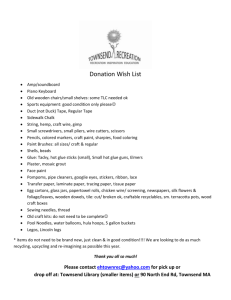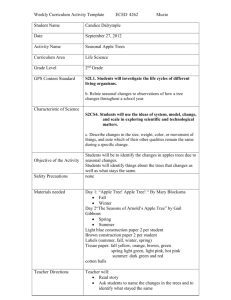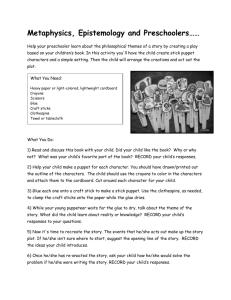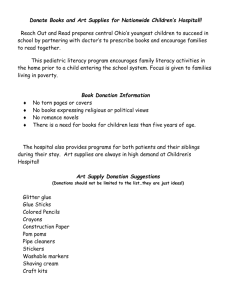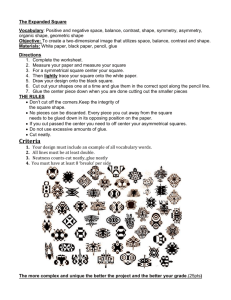A_files/Letter and Theme Activities A
advertisement
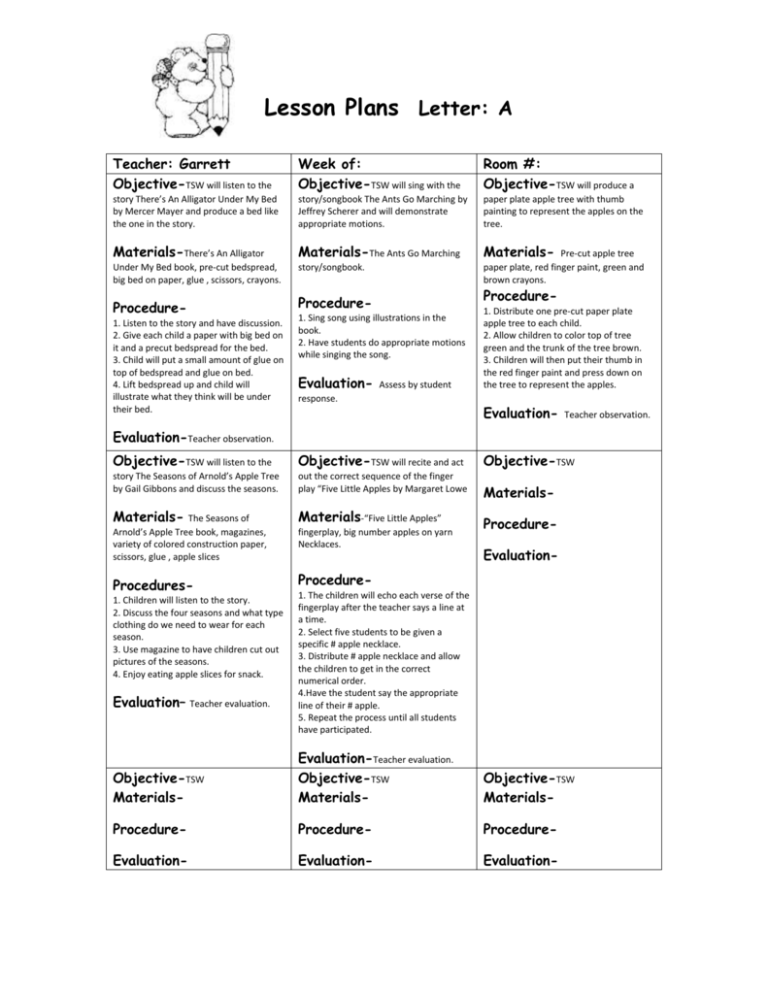
Lesson Plans Letter: A Teacher: Garrett Objective-TSW will listen to the Week of: Objective-TSW will sing with the Room #: Objective-TSW will produce a story There’s An Alligator Under My Bed by Mercer Mayer and produce a bed like the one in the story. story/songbook The Ants Go Marching by Jeffrey Scherer and will demonstrate appropriate motions. paper plate apple tree with thumb painting to represent the apples on the tree. Materials-There’s An Alligator Materials-The Ants Go Marching Materials- Under My Bed book, pre-cut bedspread, big bed on paper, glue , scissors, crayons. story/songbook. Procedure1. Listen to the story and have discussion. 2. Give each child a paper with big bed on it and a precut bedspread for the bed. 3. Child will put a small amount of glue on top of bedspread and glue on bed. 4. Lift bedspread up and child will illustrate what they think will be under their bed. Procedure- Procedure1. Sing song using illustrations in the book. 2. Have students do appropriate motions while singing the song. Evaluation- Pre-cut apple tree paper plate, red finger paint, green and brown crayons. Assess by student response. 1. Distribute one pre-cut paper plate apple tree to each child. 2. Allow children to color top of tree green and the trunk of the tree brown. 3. Children will then put their thumb in the red finger paint and press down on the tree to represent the apples. Evaluation- Teacher observation. Evaluation-Teacher observation. Objective-TSW will listen to the Objective-TSW will recite and act story The Seasons of Arnold’s Apple Tree by Gail Gibbons and discuss the seasons. out the correct sequence of the finger play “Five Little Apples by Margaret Lowe Materials- The Seasons of Materials-“Five Little Apples” Arnold’s Apple Tree book, magazines, variety of colored construction paper, scissors, glue , apple slices fingerplay, big number apples on yarn Necklaces. Procedures1. Children will listen to the story. 2. Discuss the four seasons and what type clothing do we need to wear for each season. 3. Use magazine to have children cut out pictures of the seasons. 4. Enjoy eating apple slices for snack. Evaluation– Teacher evaluation. Objective-TSW MaterialsProcedureEvaluation- Procedure1. The children will echo each verse of the fingerplay after the teacher says a line at a time. 2. Select five students to be given a specific # apple necklace. 3. Distribute # apple necklace and allow the children to get in the correct numerical order. 4.Have the student say the appropriate line of their # apple. 5. Repeat the process until all students have participated. Objective-TSW Materials- Evaluation-Teacher evaluation. Objective-TSW Materials- Objective-TSW Materials- Procedure- Procedure- Procedure- Evaluation- Evaluation- Evaluation- Theme Lesson Plans Theme: Families Objective-TSW identify family members and their roles. TSW develop an understanding of how their families function. Materials-crayons, family member chart Procedure1. Discuss with students why they think families are important and what they like about their families. Ask children to think about special contributions each family member makes to the family. 2. As children respond, create a class family chart on template and record some of their responses. Encourage children to think about their own role in their family. What do they contribute? How do they help? 3. Students create their own family chart illustrating what each family member does. Evaluation-Student identification of family members and their roles. Objective-TSW particpate in family songs, poems, and fingerplays. Materials- A Family Finger-play, Family Items, Grandmother’s Glasses, My Mother is a Baker song and printed books for students to follow along with Procedure1. Students will recite A Family Finger-play. 2. Students will recite Family Items finger-play. 3. Students will recite Grandmother’s Glasses finger-play. 4. Students will sing My Mother is a Baker by Dr. Jean using student books. Evaluation-Student participation. Objective- TSW name and identify the members of his/her family. TSW create a family craft and snack. Materials- apple sponges/big Objective-TSW identify family members. TSW connect everyday items to family members. Materials-feely box, everyday items used around the home in box such as baby rattle, perfume bottle, eyeglasses, tie, mixing spoon, toothbrush, comb, baby bottle, etc. Procedure1. Teacher places objects pertaining to a family into a box. 2. Students feel the objects in the box and try to identify them. 3. Students name object and who in family is most likely to use it. Evaluation-Student identification of objects and naming of family members. Objective-TSW create a craft representing his/her family. TSW share about his/her family through verbal expression. Materials-small empty water/soda bottle, photos of family members, trinkets, family momentos. small items from home, sequins, alphabet letters, ribbons, glitter Procedure1. Send bottle with a note home with students telling them to fill bottle with family pictures, momentos, trinkets, or any item that represents their family. 2. Students decorate bottle and label it with their name. 3. Students share their bottles with the class telling about their family. Evaluation-Student participation and verbal expression. Objective-TSW create a craft as a family and as a class. TSW identify items that tell about his/her family. Materials-fabric/felt quilt squares (you may want to include small bags filled with some items or ideas, scissors, and glue for families to use at home) Procedure1. Send fabric/felt squares home with each student. Include a note telling each family to decorate the square together using small objects from home that represent the family. 2. Students bring quilt square back to school and put together to make a class family quilt. 3. Each student tells about his/her quilt square. Evaluation-Student participation. Objective-TSW create a craft representing his/her family. Materials- magazines, glue, craft sticks, empty milk cartons covered with construction paper, craft Objective-TSW identify and appreciate similarities and differences within families. Materials-shapes, scissors, glue, crayons, house cutouts, Families are Special by Norma Simon Procedure1. Read Families are Special by Norma Simon or any family book. 2. Discuss that families come in all colors, shapes, and sizes and that no one has the same family. Discuss that families have similarities and differences. 3. Students cut out shapes and glue onto house paper cutout. Students then draw body parts onto shapes to represent that families come in all colors, shapes, and sizes. Evaluation-Student participation and fine-motor skills work. Objective-TSW tell why their family is special using sentence dictation. Materials- student handprints/hand cut-outs, glue, stamps, tree picture, paint, broccoli stalks, cherry tomatoes, ranch dressing, plates Procedure1. Students sponge paint apples onto tree picture to represent each family member. 2. Teacher writes each family member’s name under apple. 3. Students make a family tree snack by placing broccoli stalks on plate. Then they name each family member while placing a cherry tomato on plate to represent them. Serve ranch dressing on the side to make it yummy! Evaluation-Student participation, ability to follow directions, and ability to name family members. supplies Procedure1. Students cut out pictures from magazines of people to represent their family members and glue the pictures onto craft sticks (these are their family puppets). 2. Give students milk carton covered in construction paper. Students add windows, doors, etc using construction paper/craft supplies to create their house. 3. The class uses their houses to form a neighborhood or town and takes their “family members” (puppets) to visit other families. Evaluation-Student participation. crayons, pencils Procedure1. Teacher traces each student’s handprint twice and cut it out or use pre-cut handprints. 2. Students glue handprints on both ends of a long sentence strip stating “My family is special because…” 3. Students finish sentence and dictate to teacher. Evaluation-Student participation and sentence dictation ability.

